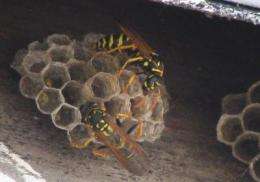Scientists find a new species of fungus -- in a wasp nest

While some researchers look for new species in such exotic places as the deep sea, tropical regions, or extreme environments, a team headed by Tufts researchers turned their attention towards nests of an invasive paper wasp. What they found was a new species of fungus.
Philip T. Starks, associate professor of biology at the School of Arts and Sciences at Tufts University, and doctoral student Anne A. Madden published their discovery in the International Journal of Systematic and Evolutionary Microbiology. The news appeared online September 19, 2011, in advance of print.
"We found the fungus in a wasp nest near the dumpsters at Tufts University," says Madden, of the discovery. The research team set out to explore a new environment for novel species of bacteria and fungi—single-celled organisms that inhabit most places in the world. Despite there being more bacterial species in the world than stars in the sky, scientists have only described approximately 10 percent of the species thought to exist, says Madden.
Attempts to identify species are hindered by the difficulty scientists encounter when working with organisms so small that hundreds of thousands can fit on the period at the end of this sentence.
These wasps often build nests on houses, trash containers and other familiar structures. "Nests of the invasive species of paper wasps had never been investigated for their microbial community," says Madden. "This is despite the wasp's cosmopolitan distribution and their frequent use as a model system in the field of animal behavior. Because researchers know so much about this host wasp, we thought it would be particularly valuable to characterize the microbes of the nest."
The scientists took samples from active nests and placed them in a nutrient-based medium as one would plant a garden with a handful of unknown seeds to see what grows. The researchers grew a number of different fungi and used genetic sequencing techniques to tease apart species identities. They found that one fungus had a unique gene sequence that suggested it had not previously been characterized.
A Fur-like Fungus
Further laboratory studies confirmed that the scientists had indeed discovered a new species, a fluffy, white and fast-growing fungus that resembled bunny fur, says Madden. The scientists named the new species of fungus: Mucor nidicola. They chose the species name nidicola, because the word translates from Latin to "living in another's nest."
The findings will contribute to understanding the diverse world of fungi. "When most people think of microbes, they immediately think of those bacteria or fungi that cause disease," says Madden. "While certain microbes do cause disease, many produce compounds or carry out reactions that are crucial for human society. In fact, most of the antibiotics on the market are actually produced by bacteria that live in the soil."
The researchers now plan to investigate further to see what other species are present in the nest's microbial community, says Madden.
"It's shocking, but also quite exciting, that we know more about what microbes live under the sea than we do about those that associate with the insects that actually live in our houses," says Starks.
More information: Madden A.A., Stchigel A.M., Guarro J, Sutton D.A., Starks P.T. Mucor nidicola sp. nov., a novel fungal species isolated from an invasive paper wasp nest. Int J Syst Evol Microbiol. [Epub ahead of print] doi:10.1099/ijs.0.033050-0
Provided by Tufts University















